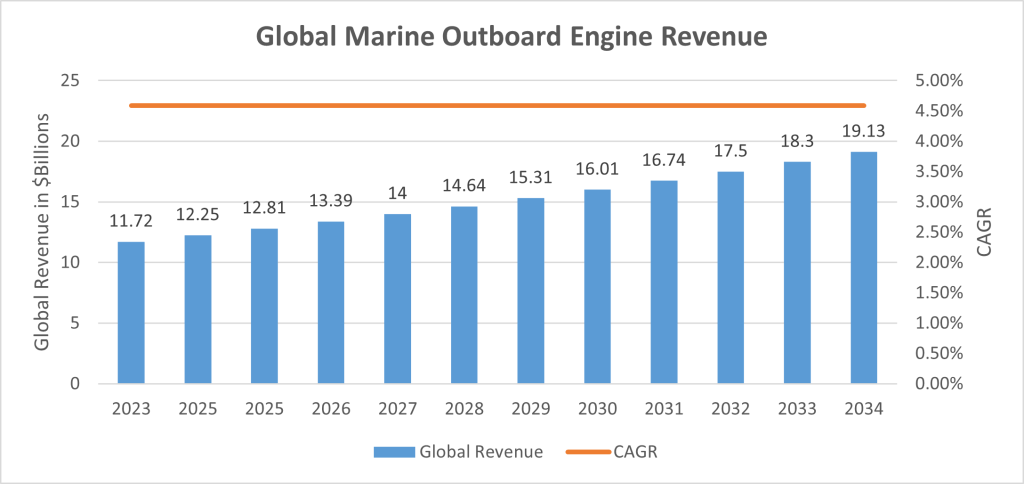GLOBAL REPORT
The global outboard engines market size was $10.58B in 2023 and is anticipated to reach $19.13B by 2034, growing at a CAGR of 5.53% from 2024 to 2034, according to Power Systems Research (PSR).

Source: Power Systems Research
Summary. The outboard engines market produces, sells, and distributes outboard motors. These engines are independent propulsion units positioned externally on a boat’s transom instead of being integrated within the hull. These engines, which are used to power a variety of watercraft, such as boats, dinghies, pontoons, and fishing vessels, usually consist of a powerhead, gearbox, and propeller.
Demand Drivers. Today, many people are participating in water-related recreational activities, and the economic growth of the country, increasing consumer confidence, and technological innovations by boat manufacturers all are driving growing demand.
- OEMs are focusing on building versatile and affordable products to appeal to youth.
- Intuitive marine technology makes it easy to operate these products.
- The growing boat rental market and shared boat ownership are pushing outboard motor ownership.
- The surging popularity of environmentally friendly outboard engines cater to the preferences of eco-conscious consumers.
- While electrification addresses environmental concerns and the regulatory push for reducing carbon footprints, challenges like noise pollution and high initial costs persist. Hybrid and electric outboard engines, powered by lithium-ion batteries, offer alternative fuel options, catering to the evolving demands of maritime tourism, water skiing, and cruising.
- Government organizations, marine service providers, and scientific research entities drive environmental monitoring initiatives.
- The demand for new boats and outboard engines is heavily influenced by factors such as fuel efficiency and income levels. Increasing disposable income plays a vital role.
- The tourism industry contributes significantly to the market’s growth, as recreational boating remains a popular activity for tourists and locals alike.
- The need for boats with dependable outboard engines has increased due to the expansion in maritime tourism, which includes activities like island hopping, whale watching, and sightseeing excursions.
- There is a natural market demand for replacement engines as older models age or become less efficient, especially from boat owners who value dependability and performance.
Market Trends. There are three important developing trends in this segment: Increased usage of turbochargers, a growing interest in electric outboard engines and expanded use of digital technology.
- Turbochargers increase the volume of air to the combustion process without any additional requirement for large displacement cylinders.
- Electric outboard engines offer quieter operation, reduced emissions, and lower maintenance requirements.
- Digital technology is increasingly integrated into outboard engines, offering features such as digital controls, touch-screen displays, and connectivity options.
Market Challenges. The performance of the global economy is a critical factor affecting the boating industry as the demand for marine outboard engines is usually cyclic with fluctuations in the economy.
A growing number of purchasers are choosing engines built to reduce pollution in water bodies that either meet or surpass emission regulations. Greener consumers are increasingly drawn to outboard motors that run on natural gas or propane and electric outboard engines.
Market Overview. PSR anticipates steady growth in the coming years, driven by the rising popularity of watersports and recreational boating activities. More reliable and quieter new engine models cater to both younger and older generations, enhancing leisure experiences.
There is a rising need for greener and more sustainable outboard engine alternatives to conventional gasoline-powered ones as environmental concerns become more widely recognized. Outboard motors powered by electricity and hybrid technology have reduced noise pollution, emissions, and dependency on fossil fuels. PSR
Michael Aistrup is Senior Analyst at Power Systems Research

